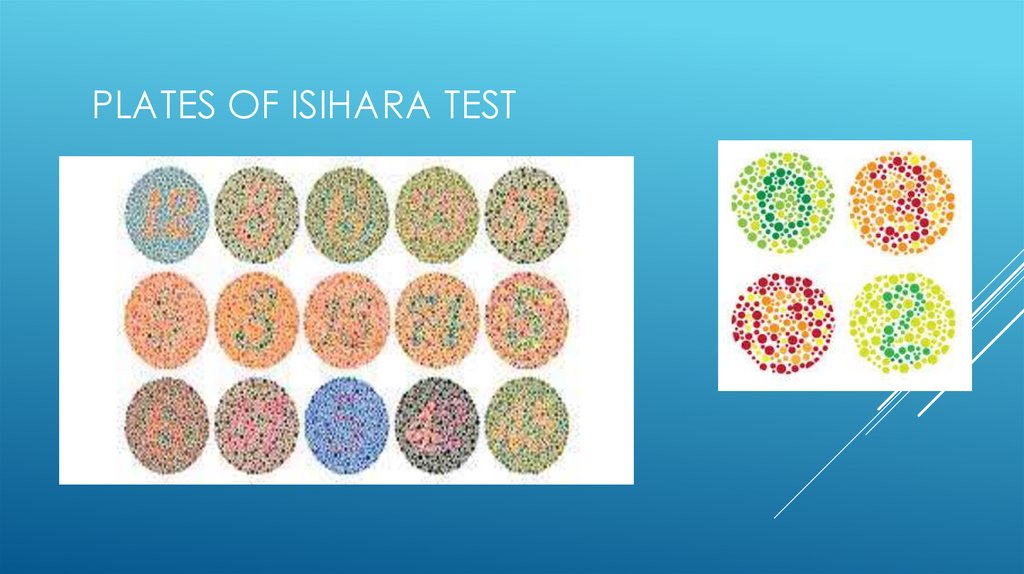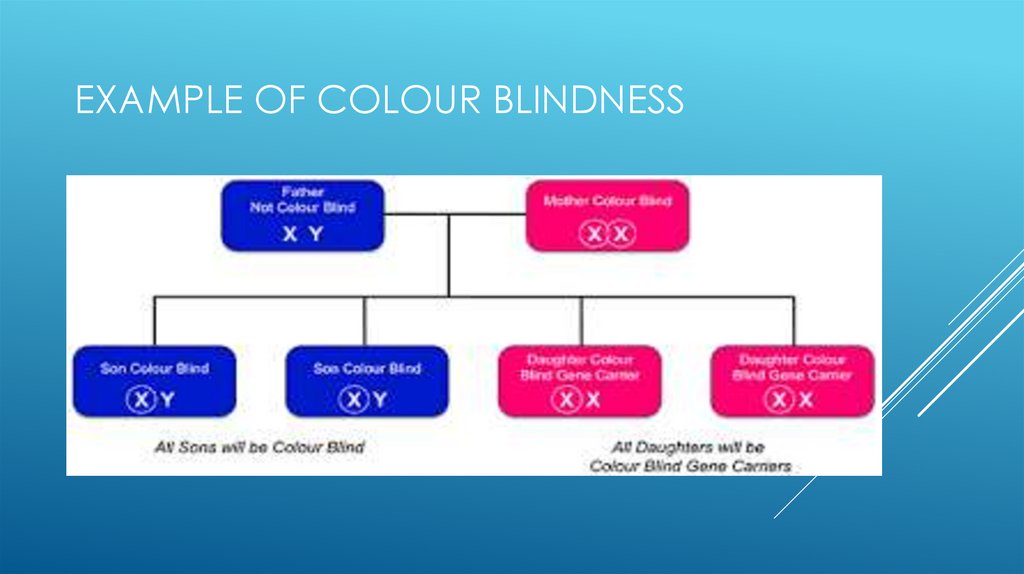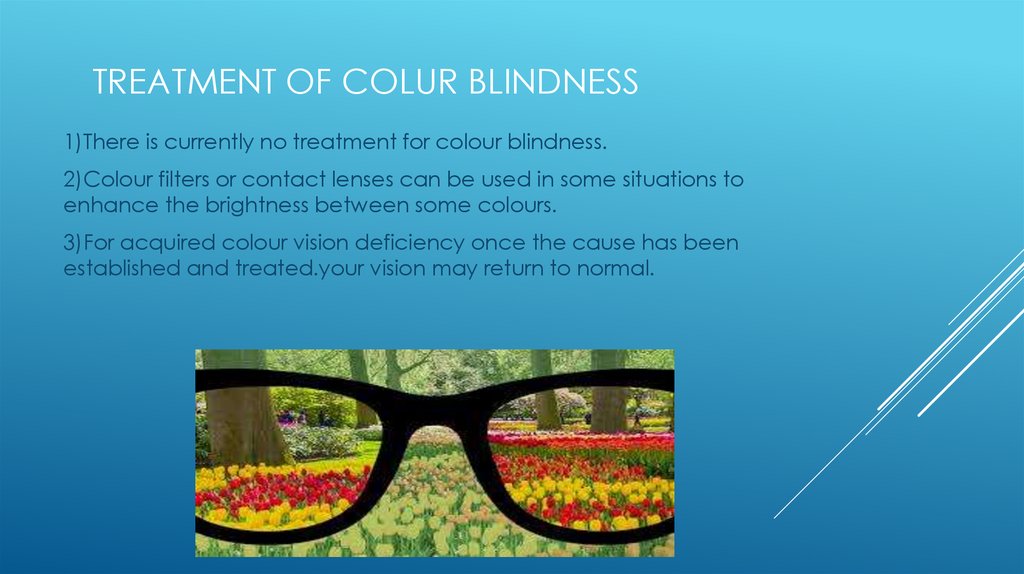Similar presentations:
Medical biology
1.
MEDICAL BIOLOGYDone by:
R.Sugisenan
2.
COLOUR BLINDNESS3.
INTRODUCTIONWhat is colourblindness?
colour blindness is a defect of vision that
makes a person impossible/difficult for a person to
distinguish between or among colurs
4.
TYPES OF COLOUR BLINDNESS1)TRICHOMACY (three colour vision)
Normal colour vision
2)ANAMOLOUS TRICHOMACY(unusual three colour
vision)
*Protonomaly(I cone defect)red weak
*Deuteranomaly(M cone defect)green weak
*Tritonomaly(S cone defect)blue weak
5.
SYMPTOMSThe symptoms vary ,some people may be able
to see every colour but not distinguish red or
green .Other may not be able to see blue or
yellow .Lastly ,some people may not be able to
see colour at all .They may just able to see
shades of black, white and gray. This however is
very rare condition in human .
6.
PEOPLE LIVING WITH COLOUR BLINDNESS*Colour blind people face many difficulties in everyday
life
*Problems can arise in even the most simple of activities
including choosing and preparing
,food,gardening,sport,driving carandselecting clothimg
*Colour blind people can also find themselves in trouble
because they haven’t been able to pick up a change
in someones mood by a change in colour of their face
7.
BASIC CONES PRESENT IN EYESThere are three types of cones
*L cones (sense of long wavelength)red light
*M cones (sense of medium wavelength)green light
*S cones(sense of shorter wavelength)blue light
These are classified on the basis of photoreceptor protein
8.
CAUSES OF COLOUR BLINDNESS1)Usually genetic condition
$ Red/green/blue colour blindness is passed down from parents.
$the gene responsible is on X chromosome.
$Mutation capable of causing colour bilindness orginates from
atleast 19 different chromosome and many different genes.
$more males are affected the females are basically.
$There is 50 percent chance of mother passing this condition to
her son.
9.
2)ACQUIRED COLOUR BINDNESS$Aging
$Eye problems such as glaucoma,macular
degeneration ,cataracts,or diabietic retinopathy.
$injury in the eye
$ Side effects of some medicines.
$If you have inherited colour blindness your condition
will stay the same throughout yourlife it won’t get any
better or worse
10.
INHERITED CONDITION IS DUE TO FOLLOWINGIn our eyes there are two types of light sensitive cells.
1)rods
2)cones
Both found in retina which is a layer at back of eye it
process images.
The rods are responsible for vision in night as work in low
light condition(cannot distinguish different wavelength
of light)
The conesare responsible for colour discrimination.
11.
AFFECTED EYE OF A PERSON12.
INHERITANCE PATTERNS$Red green colour blindness is usually inherited from parents.
$It is passed from mother to son on 23rd chromosomes which
is sex chromosomes which is sex chromosome.
$Chromosomes are the structure which contain genes they
contain instruction for the development of cell tissues organ
and if you are colour blind it means instruction for cone
development are wrong.
$It may bemissing or less sensitive.
$Orr pathaway from cone to brain is not developed properly.
13.
$ For males to be colour blind his X chromosome should havethe faulty gene.
$The female might have both X chromosomes normal or one
X chromosome might have faulty gene but gene on other
chromosomes compensates it so the female is carrier and
passes on faulty gene to her son so he is colour blind.
$The daughter might be carrier or colourblind if her father is
colourblind and mother is the carrier.
$By this information males more affected by colour blindness
than female as the number of X chromosomes is more in
females
14.
TESTS FOR COLOUR BLINDNESS1)PSEUDOISOCHROMATIC PLATE TEST
2)ISIHARA TEST
3)TRANSFORMATION PLATE
4)VANISHING PLATE
15.
ISHIARAS TEST$There are many tests available to measure colour vision defects
but most common is the ishiara test plate test.
$This test is for red/green colour blindness but not blue colour
blindness.
$This is the test most likely to be used for routine colour vision
screening in schools or medicals.
$This test contains 38 plates of circles created by irregular coloured
dots in two or more colours.
16.
PLATES OF ISIHARA TEST17.
18.
EXAMPLE OF COLOUR BLINDNESS19.
TREATMENT OF COLUR BLINDNESS1)There is currently no treatment for colour blindness.
2)Colour filters or contact lenses can be used in some situations to
enhance the brightness between some colours.
3)For acquired colour vision deficiency once the cause has been
established and treated.your vision may return to normal.




















 biology
biology








